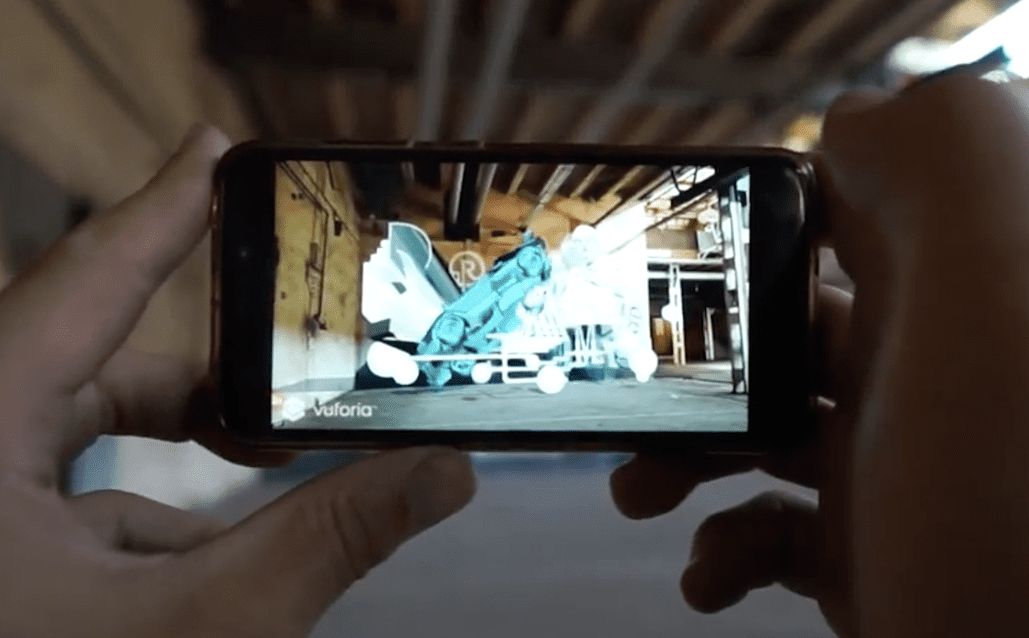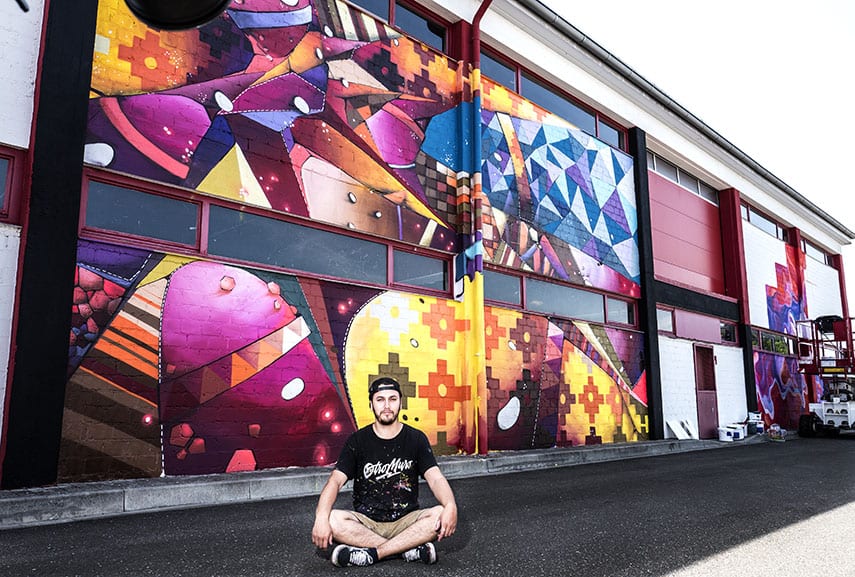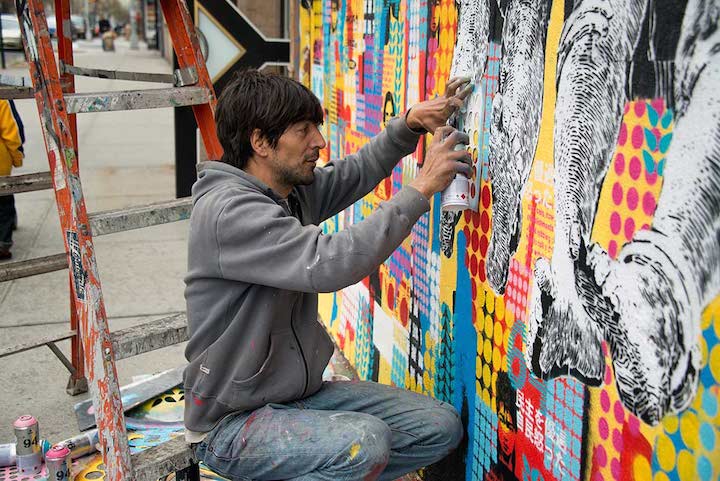Brazilian Street Art Festival “Fest.AR” Adds a VR Twist
São Paulo, a city widely recognized its thriving urban art scene, will host the first edition of “Fest.AR – Graffitis Apagados de São Paulo”, an unprecedented virtual reality event in South America. The initiative seeks to rescue works by 13 artists from different street art variations that have marked the city’s cultural life in the last four decades, aiming to heighten the historical heritage of the municipality and promote a constructive dialogue between the population and the city itself, in a way never before seen.
Fest.AR is an iconic event that promotes the rescue of São Paulo’s cultural heritage through the virtual delivery of ephemeral works such as graffiti, lettering, and murals in points of Avenida Paulista and surrounding areas, which were erased at some point by the natural evolution that cities experience, especially big ones like São Paulo.
Organized by MOVA and conceived by multimedia artist Giovanna Graziosi Casimiro, a researcher in digital memory and contemporary heritage, the festival also brings curatorship from cultural producer Vera Santana, and artist Prila Maria.
Prila was responsible for the entire research process, cataloging, and inviting 3 female protagonists with high relevance in the region: Loba Gi, Sujeitas, and OPS (Vismoart); in addition to graffiti artist Subtu. The festival also features the works of 6emeia, Jaime Prades, Bueno Caos, Mauro Neri, Nina Pandolfo, Nove, SHN, Tinho, and Rui Amaral.
The event will be live until December 28 and consists of a simple process: to experience Fest.AR, the user needs to download an application for free on their cell phone (available on Android and soon on iOS), the application will indicate the physical locations of the old pieces of art through geolocation options, by directing your cell phone to the indicated location, it will be possible to view the work that was once there, photograph it and film it, even with you on the picture, as if it were current reality, providing interactivity with the times that only current technology can achieve.
The festival’s progress is being updated through the Instagram profile @_fest.ar/, and, additionally Fest.AR promotes free virtual workshops through their social media accounts. These are given by Giovanna Graziosi Casimiro and started on December 5, with theoretical content and practical activities related to augmented reality as an instrument of urban occupation.
With 3 more weeks left, Fest.AR promises to be a great experience to both fans of street art and VR enthusiasts, and represents an important step in the evolution of urban art, making us wonder about the possibilities that new technologies could bring on how we appreciate it.
Sebastián Antonio Carreño Gaibisso (UNONUEVE)
Sebastián Antonio Carreño Gaibisso, also known as UNONUEVE, is a self-taught visual artist, a native of the San Antonio commune of Chile. Closely acquainted with painting since childhood, using basic materials he had at hand, self-taught exploration allowed him to create characters from his imagination. Sebastián developed his style of art through the manipulations of color saturation, shapes, and textures that he uses in his subjects, which he generates from inspirations of the Andean culture. The art of UNONUEVE can be found around the world in different formats; from paper to large murals distributed in countries such as Chile, Brazil, Mexico, Colombia, Germany, Netherlands, and Spain.
Although he was able to discover his motivation and interest in art and painting when he was young, it was not until he began his studies as a graphic designer that he began to create his own line of work, based on transmitting emotions through color, shapes, and textures.
Sebastián is heavily influenced by the crafts of Peru, Chile, and Mexico; styles typical of Latin American culture, very daring in their use of color with frequent mixing of cold and warm shades. Through his works, Sebastián seeks to convey a message of spiritual elevation; coming in contact with that which is beyond the tangible, exploring the expression of feelings and the connection with the universe that his ancestors spoke of.
He is always in constant search of new techniques and materials to use in his pieces, which has led him to travel to different parts of the world, participating in international festivals of public art and exhibitions. Sebastián’s style is constantly evolving and this progression can be seen in the works he posts on his Instagram account: https://www.instagram.com/onenain/
Alapinta Colectivo
Initially composed of Aner Urra (ANER), Claudio Cabrera (KAIO), Claudio Maher (MAHER), and Gabriel Veloso (GVZ), Alapinta is a collective of Chilean artists who have been painting since 2004. Inspired by public art, graffiti, and murals, they have adapted their style to fit many different public and private spaces, painting murals to promote health, education, culture, heritage, and the environment, among others.
The original members met while studying graphic design and soon started going out together to paint after classes. Currently, the group is composed only of MAHER and GVZ who organize many collaborative community murals where people can join in.
Their commitment has been to transform various public and private spaces through the addition of high-quality art; leaving their unique signature and various messages that highlight identity, culture, and nature.
Alapinta has painted and organized murals in different parts of the world, each of which having a unique flavor and identity based on the space in which it is created. They are on record stating that people’s perception has a lot to do with identifying the themes they choose to work with. Therefore, they tend to do a lot of research regarding the place, its history, and how people living there interact with their surroundings. The joy for them is that they get to deliver a statement of hope, which is one of the engines that move them.
In the course of their 15 years of trajectory, Alapinta has continued to hone their talent through countless productions. Have a look at their Instagram account here to get a sense of the scope of their work: https://www.instagram.com/alapinta.cl/
Santiago Spirito (Cabaio)
Santiago Spirito (the real name of urban artist Cabaio) began painting in the streets of Buenos Aires after the 2001 Argentine economic crisis. Acting as part of a collective known as “Vómito Attack,” he, together with his fellow artists, sought to influence the political debate by stenciling political messages and drawing people’s attention to issues such as consumerism and commercialization of public spaces.
Santiago (Cabaio) first got interested in stencil techniques through a coworker in a restaurant, and the issue of commercial messaging on the streets of his city was something that he had been concerned about for some time. He was horrified by the amount of information that was and still is, displayed in the streets; from billboards, numbers, shops, t-shirts, and much more, an absurd amount of information that, just through passive reading and being a little curious, somehow permeates your thoughts and attitudes. Along with his friends, he was interested in the idea of creating urban interventions in these highly saturated spaces by offering other kinds of information, not just commercial slogans. That was the moment Vómito Attack emerged, (and yes, that means what you think it means), a name conceived to describe the saturation of information people are subjected to just by walking down the street. After several years of activism and interventions, Santiago parted ways with the collective in 2007 to work on his own solo project.
While his works as part of the collective were based on heated criticism and protest, his work as a freelance artist could be considered apolitical. Cabaio changed his focus in order to experiment with art, embellishing a chosen walls, privileging aesthetics over political messages. His murals often combine colorful wheat pastes, stencils, and hand-drawn details. The final effect emerges as an elaborate layered collage with combined images, creating beautiful kaleidoscopic murals.
Cabaio tries to match his creations to the street where he places them; mixing and matching colors and images, using the street as a supplier of materials essential for his work, such as spray paint can leftover from other works, objects that serve as frames, radiographs to use as templates.
More of Cabaio’s characteristic collages can be appreciated on his Instagram account here: https://www.instagram.com/cabaiospirito/
Georgina Ciotti
Georgina Ciotti was born in Buenos Aires, Argentina and from a very young age was always involved in art and especially linked to drawing, painting, and workshops. Like all of the other artists included here, this natural lead her to eventually become involved in the South American street art scene.
Her works have been described as very powerful and the strength they project can be at least partly attributed to her training as a designer and illustrator. Her expression as an artist coupled with this technical expertise allows her to create truly remarkable urban murals with otherworldly characters. An interesting side-note, If you have seen the movies Pan’s Labyrinth and Hellboy 1 and 2 you will have already been exposed to her work as she was part of the special effects team that produced these award winning films!
After dedicating herself entirely to painting, she began specializing in murals and urban interventions, of which she was a large part of in Barcelona. Her works tend to have a strong visual impact, made up by complex beings and shapes that represent beasts of her creation or female characters with decorative elements, resulting in surreal compositions that transport us to another world.
At the end of 2009, she returned to Argentina, where she continues to paint and make murals. Currently, she works as a plastic artist, illustrator, and designer specializing in murals and public and private urban interventions. To see more of her work check for updates updates on her Instagram account here: https://www.instagram.com/ciotti.georgina/




